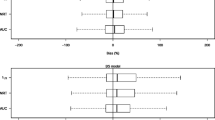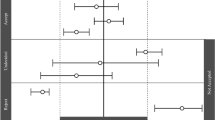Abstract
Purpose
To predict steady-state metabolite-to-drug concentration ratio (metabolic ratio) for analgesic drug remifentanil, using sparse non-steady-state data from patients with normal or impaired renal function during individualised, highly variable and rapidly adaptive intravenous infusion.
Methods
A three-compartment joint parent-metabolite population pharmacokinetic model was developed using concentrations of remifentanil and its metabolite remifentanil acid from two trials. Renal function was included as an important mechanistic covariate. To address the large covariate effect and highly individualised and rapidly adaptive dosing, standardised visual predictive check was conducted on the observations and individualised visual predictive check was conducted on metabolic ratio estimates. The model was used to simulate metabolic ratio distribution in patients with various renal functions.
Results
The model, including its covariate structure, adequately described the data. The predictive checks allowed informative model evaluation. The predicted median (10th - 90th percentile) of remifentanil metabolic ratio was 12.5 (2.4–58.2) for patients with normal or mildly impaired renal function, or 54.3 (12.8–218.4) for patients with moderately or severely impaired renal function.
Conclusions
The methodologies applied here allowed robust estimation of steady-state parameters using non-steady-state sparse data under highly variable adaptive dosing.







Similar content being viewed by others
Abbreviations
- B:
-
Exponent for Metabolic Ratio
- CI:
-
Confidence Interval
- CL:
-
Remifentanil Clearance
- CLM:
-
Elimination Clearance of the Metabolite Remifentanil Acid
- CRCL0:
-
Baseline Creatinine Clearance
- iVPC:
-
Individualised Visual Predictive Check
- k0 :
-
Infusion Rate
- M2 :
-
Amount of Remifentanil Acid in Its Blood Compartment
- M3 :
-
Amount of Remifentanil Acid in Its Tissue Compartment
- MR:
-
Metabolic Ratio
- MRmax :
-
Maximal Metabolic Ratio
- pcVPC:
-
Prediction-corrected Visual Predictive Check
- Q:
-
Remifentanil Acid Distribution Clearance
- R1 :
-
Amount of Remifentanil in Its Blood Compartment
- sVPC:
-
Standardised Visual Predictive Check
- V1 :
-
Remifentanil Blood Compartment Volume
- V2 :
-
Remifentanil Acid Blood Compartment Volume
- V3 :
-
Remifentanil Acid Tissue Compartment Volume
- VPC:
-
Visual Predictive Check
References
GlaxoSmithKline (UK). ULTIVA summary product characteristics. 14 May 2015.
Westmoreland CL, Hoke JF, Sebel PS, Hug CC Jr, Muir KT. Pharmacokinetics of remifentanil (GI87084B) and its major metabolite (GR90291) in patients undergoing elective inpatient surgery. Anaesthesiol. 1993;79:893–903.
Dershwitz M, Hoke F, Rosow C, Michalowski P, Connors P, Muir K, et al. Pharmocokinetics and pharmacodynamics of remifentanil in volunteer subjects with severe liver disease. Anaesthesiol. 1996;84:812–20.
Kapila A, Glass PS, Jacobs JR, Muir KT, Hermann DJ, Shiraishi M, et al. Measured context-sensitive half-times of remifentanil and alfentanil. Anesthesiol. 1995;83:968–75.
Hoke JF, Shlugman D, Dershwitz M, Michalowski P, Malthouse-Dufore S, Connors PM, et al. Pharmacokinetics and pharmacodynamics of remifentanil in persons with renal failure compared with healthy volunteers. Anesthesiol. 1997;87:533–41.
Breen D, Wilmer A, Bodenham A, Bach V, Bonde J, Kessler P, et al. Offset of pharmacodynamic effects and safety of remifentanil in intensive care unit patients with various degrees of renal impairment. Crit Care. 2004;8:21–30.
Breen D, Karabinis A, Malbrain M, Morais R, Albrecht S, Jarnvig IL, et al. Decreased duration of mechanical ventilation when comparing analgesia-based sedation using remifentanil with standard hypnotic-based sedation for up to 10 days in intensive care unit patients: a randomised trial [ISRCTN47583497]. Crit Care. 2005;9:R200–10.
Bender J, van den Elshout J, Selinger K, Broeders G, Dankers J, van der Heiden C. Determination of remifentanil in human heparinised whole blood by tandem mass spectrometry with short-column separation. J Pharm Biomed Anal. 1999;21:559–67.
Pitsiu M, Wilmer A, Bodenham A, Breen D, Bach V, Bonde J, et al. Pharmacokinetics of remifentanil and its major metabolite, remifentanil acid, in ICU patients with renal impairment. Br J Anaesth. 2004;92:493–503.
Frame B, Miller R, Lalonde RL. Evaluation of mixture modeling with count data using NONMEM. J Pharmacokinet Pharmacodyn. 2003;30:167–83.
Lemenuel-diot A, Laveille C, Frey N, JochemsenR MA. Mixture modeling for the detection of subpopulations in a pharmacokinetic/Pharmacodynamic analysis. J Pharmacokinet Pharmacodyn. 2006;34:157–81.
Carlsson KC, Savić RM, Hooker AC, Karlsson MO. Modeling subpopulations with the $MIXTURE subroutine in NONMEM: finding the individual probability of belonging to a subpopulation for the use in model analysis and improved decision making. AAPS J. 2009;11:148–54.
Wang DD, Zhang S. Standardized visual predictive check versus visual predictive check for model evaluation. J Clin Pharmacol. 2012;52:39–54.
Bergstrand M, Hooker AC, Wallin JE, Karlsson MO. Prediction-corrected visual predictive checks for diagnosing nonlinear mixed-effects models. AAPS J. 2011;13:143–51.
Simeoni M, Bullman J, Chen C. Prediction of remifentanil metabolic ratio using sparse data collected during non-steady-state infusion with rapidly changing rate. PAGE 18. 2009; Abstr 1578 [www.page-meeting.org/?abstract=1578].
Holford NH. The visual Predictive Check-Superiority to standard diagnostic (Rorschach) plots. Population Approach Group Europe Annual Meeting. 2005; Abstr 738 [www.page-meeting.org/?abstract=738].
Mentré F, Escolano S. Prediction discrepancies for the evaluation of nonlinear mixed-effects models. J Pharmacokinet Pharmacodyn. 2006;33:345–67.
Brendel K, Comets E, Laffont C, Laveille C, Mentré F. Metrics for external model evaluation with an application to the population pharmacokinetics of gliclazide. Pharm Res. 2006;23:2036–49.
Brendel K, Comets E, Laffont C, Mentré F. Evaluation of different tests based on observations for external model evaluation of population analyses. J Pharmacokinet Pharmacodyn. 2010;37:49–65.
Largajolli A, Bertoldo A, Campioni M, Cobelli C. Visual predictive check in models with time-varying input function. AAPS J. 2015;17:1455–63.
Acknowledgments and Disclosures
We thank Jonathan Bullman and remifentanil project team for their support, and Dr. Martin Bergstrand for discussion on prediction-corrected visual predictive check. Funding for this analysis was provided by GlaxoSmithKline. All authors meet the criteria for authorship set forth by the International Committee for Medical Journal Editors. The authors are employed by GlaxoSmithKline and declare no conflict of interest.
Author information
Authors and Affiliations
Corresponding author
Rights and permissions
About this article
Cite this article
Simeoni, M., Chen, C. Population Pharmacokinetic Modelling for Estimation of Remifentanil Metabolic-Ratio Using Non-steady-State Concentrations under Rapidly Adaptive Dosing. Pharm Res 35, 216 (2018). https://doi.org/10.1007/s11095-018-2508-0
Received:
Accepted:
Published:
DOI: https://doi.org/10.1007/s11095-018-2508-0




